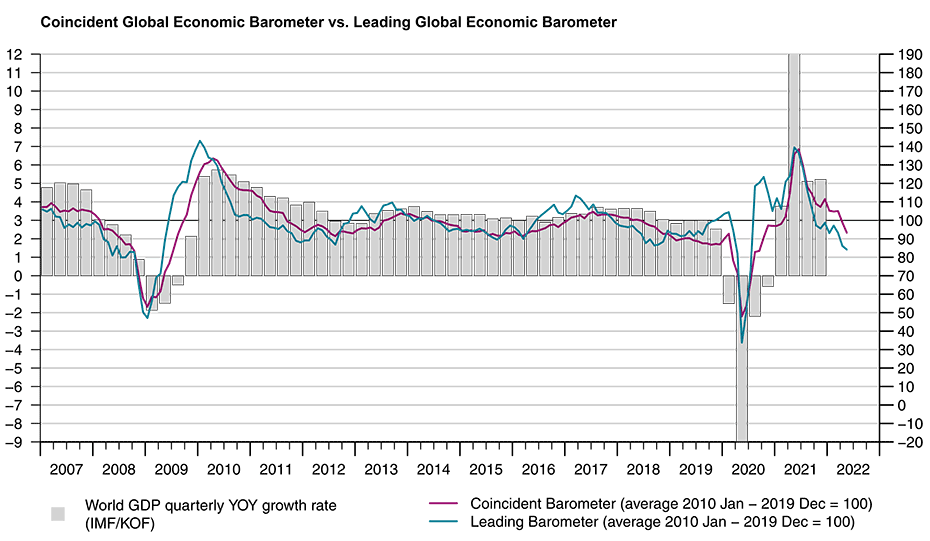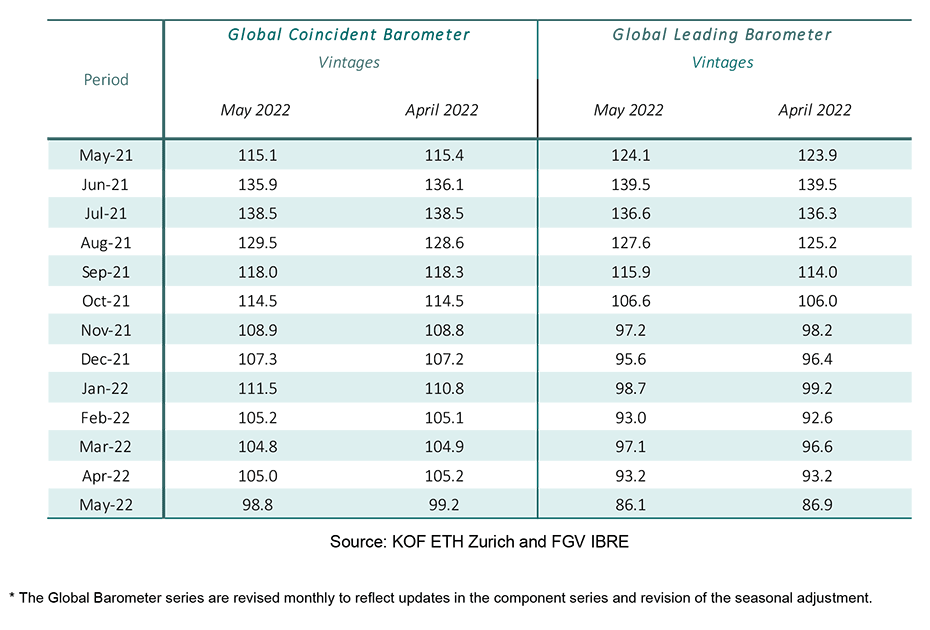Global Barometers signal world slowdown to intensify in the coming months
The Global Barometers fall for the second consecutive month, reflecting negative factors such as the war between Russia and Ukraine, the COVID-19 responses in China and the worldwide very high inflation. The Coincident Barometer remains below the historical mean of 100 points, while the Leading Barometer drops further from the mean, reflecting the increased risk of a more pronounced slowdown in several countries.
The Coincident Global Economic Barometer falls 5.5 points in May to 93.3 points, the lowest level since October of last year (90.7 pts), while the Leading Global Economic Barometer decreases 1.9 points, to 84.2 points, the lowest level since July 2020 (72.9 pts). This month’s results are influenced mainly by the Asia, Pacific, and Africa region followed by the Western Hemisphere.
“Albeit from a high level, the coincident barometer has fallen by almost 20 points, or nearly two standard deviations, since the beginning of this year. Part of this lies in the nature of things: the demand-pull recovery from the pandemic, while still present, is no longer gaining much strength and is by definition temporary. However, also the cost-push shocks to the global economy from renewed supply chain problems emerging in China and higher commodity prices triggered by the war in Ukraine are having their impact. In this environment, consumers and producers are becoming increasingly concerned about more stubbornly high than expected inflation rates. For many, we are in uncharted territory, and this kind of uncertainty is in itself poison for the economy”, evaluates Jan-Egbert Sturm, Director of KOF Swiss Economic Institute.

Coincident Barometer – regions and sectors
In May, the three regional coincident indicators decrease. The Asia, Pacific, and Africa region negatively contributes 2.9 points (53%) to the fall in the Coincident Global Barometer. The indicators for Europe and the Western Hemisphere contribute 1.8 and 0.8 points (33% and 15%) respectively to this decline. The second consecutive drop in all three regional indicators confirms the increased scepticism regarding world economic growth in the face of the responses to pandemic developments in China, the Russia-Ukraine war, and the high levels of inflation in various countries around the world. The graph below illustrates the contribution of each region to the deviation of the Coincident Barometer from the historical mean of 100 points.
All coincident sector indicators clearly decrease this month. The largest falls come from Construction and the general state of the Economy (aggregated business and consumer evaluations), followed by Industry, Services and Trade. With this result, all five sector indicators are now below their historical mean of 100 points.
Leading Barometer – regions and sectors
The Leading Global Barometer leads the world economic growth rate cycle by three to six months on average. In May, the Asia, Pacific, and Africa region and the Western Hemisphere contribute negatively to the result of the global indicator, with -3.2 and -1.9 points, respectively, while Europe moves in the opposite direction with a positive contribution of 3.2 points. The result suggests that growth expectations for the coming months have been strongly revised in the first two regions, due to the COVID-19 responses in China and possibly because of the more restrictive monetary policy in the United States to contain the advance of inflation. The regional indicator for Europe recovers half of its losses in the previous month due to the outbreak of the war between Russia and Ukraine.
In May 2022, there is a fall in three of the five Leading indicator sectors. The largest fall comes from the indicator for the general state of the Economy (aggregated business and consumer evaluations), followed by Services and Industry. In the opposite direction, Construction rises more than 6 points and Trade shows a slight increase for the month. The result suggests that global worsening of inflation is cause for concern among consumers and business, in addition to the existing problems in industrial supply chains in various countries, which are being extended by the conflict in Europe and the reactions to pandemic developments in China.

The Global Economic Barometers
The Global Economic Barometers are a system of indicators enabling timely analysis of global economic development. They represent a collaboration between the KOF Swiss Economic Institute of the ETH Zurich in Switzerland and Fundação Getulio Vargas (FGV), based in Rio de Janeiro, Brazil. The system consists of two composite indicators, the Coincident Barometer and the Leading Barometer. The Coincident Barometer reflects the current state of economic activity, while the Leading Barometer provides a cyclical signal roughly six months ahead of current economic developments.
The two Barometers comprise the results of economic tendency surveys conducted in more than 50 countries with the aim of achieving the broadest possible global coverage. The advantages of economic tendency surveys are that their results are usually readily available and are not substantially revised after first publication.
The Coincident Barometer includes more than 1,000 different time series, while the Leading Barometer consists of over 600 time series. Cross-correlation analysis is used to decide which individual time series are included in the barometers. This involves correlating the individual time series with a reference series. The reference series used is the year-on-year growth rate of global gross domestic product (GDP), where the individual national GDPs are aggregated at purchasing power parity to form global GDP. A time series is only included in a Barometer if it shows a sufficiently high correlation and a suitable synchronization or lead with the reference series. The time period used for this correlation analysis currently runs from January 2010 to December 2019.
The series of the two Barometers are revised each month at publication and are standardized to have a mean of 100 and a standard deviation of 10 for the 10-year period previous to the most recent observations.
The methodology is described in:
Klaus Abberger, Michael Graff, Aloisio Jr. Campelo, Anna Carolina Lemos Gouveia, Oliver Müller and Jan-Egbert Sturm (2020), The Global Economic Barometers: Composite indicators for the world economy. KOF Working Papers, vol. 471, Zurich: KOF Swiss Economic Institute, ETH Zurich, 2020.
Contact
KOF Konjunkturforschungsstelle
Leonhardstrasse 21
8092
Zürich
Switzerland